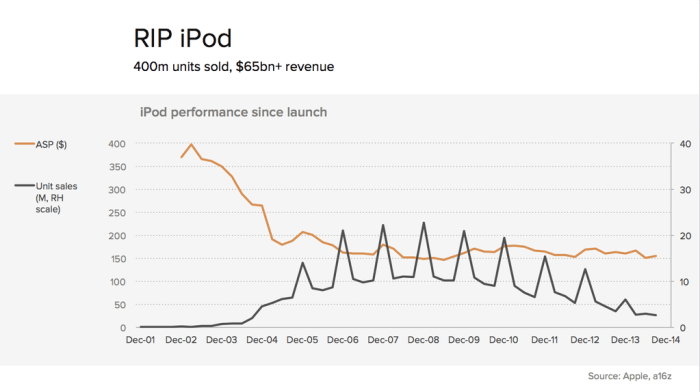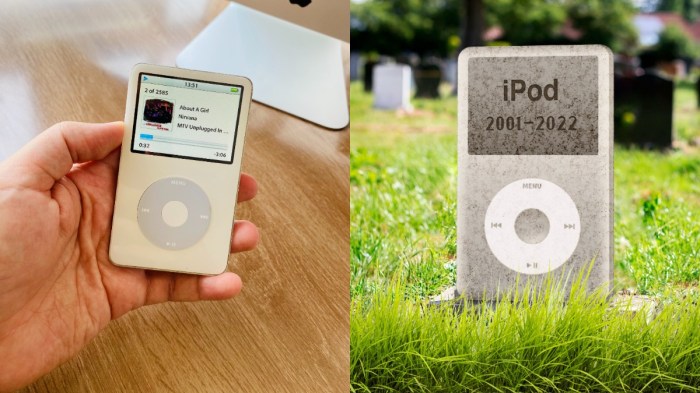The Rise and Fall of the iPod
The iPod, Apple’s iconic digital music player, revolutionized the music industry and transformed how we consume music. It was a game-changer, not just for Apple, but for the entire music industry and how we listen to music. While its reign eventually came to an end, the iPod’s legacy lives on, shaping the way we interact with technology and consume media today.
The iPod’s Impact on the Music Industry and Consumer Behavior
The iPod’s impact on the music industry and consumer behavior was profound. Before the iPod, the dominant way to listen to music was through CDs, which were bulky and prone to scratches. The iPod offered a compact, portable solution that could hold hundreds of songs. This convenience, coupled with the iPod’s user-friendly interface, made it a hit with consumers. The iPod also played a crucial role in the rise of digital music distribution. Prior to the iPod, the only way to buy digital music was through online stores like Napster, which was notorious for its illegal file-sharing practices. Apple’s iTunes Store, launched in 2003, offered a legal and convenient way to buy digital music, making it the world’s leading digital music retailer. This shift from physical CDs to digital downloads transformed the music industry, leading to a decline in CD sales and a surge in digital music consumption.
Factors Contributing to the iPod’s Initial Success
The iPod’s success was a result of several factors.
- User-friendly interface: The iPod’s interface was simple and intuitive, making it easy for users to navigate and find their music. Apple’s attention to detail and user experience design was a key differentiator.
- Seamless integration with iTunes: The iPod was tightly integrated with iTunes, Apple’s desktop music management software. This integration made it easy to transfer music to the iPod and manage playlists.
- Marketing and branding: Apple’s marketing campaigns for the iPod were highly effective, creating a sense of desirability and exclusivity around the product. The iconic silhouette of the iPod, with its white earbuds, became synonymous with music and style.
- Innovation and product design: Apple continuously innovated and refined the iPod, introducing new features and models. The iPod’s sleek design and compact size were highly desirable, making it a status symbol for many.
The Evolution of the iPod
The iPod underwent several significant evolutions over its lifespan.
- The Original iPod (2001): The first-generation iPod was released in 2001 and featured a 5GB hard drive, a monochrome display, and a scroll wheel for navigation. It could hold up to 1,000 songs.
- The iPod Mini (2004): The iPod Mini was a smaller and more affordable version of the original iPod, featuring a color display and a 4GB hard drive.
- The iPod Nano (2005): The iPod Nano was a further miniaturization of the iPod, featuring a sleek design and a small form factor.
- The iPod Touch (2007): The iPod Touch was a revolutionary model that combined the iPod’s music playback capabilities with a touchscreen interface and internet connectivity.
- The iPod Classic (2007): The iPod Classic was a larger version of the iPod, featuring a 160GB hard drive and a color display. It was discontinued in 2014.
Factors Contributing to Declining Sales
The iPod, once a cultural phenomenon, experienced a dramatic decline in sales, ultimately leading to its discontinuation. This decline can be attributed to a confluence of factors, including the rise of smartphones, the emergence of streaming services, and technological advancements that rendered the iPod less relevant.
The Rise of Smartphones
Smartphones, with their integrated music players, internet connectivity, and app ecosystems, fundamentally altered the landscape of portable music consumption. Smartphones offered a comprehensive and versatile experience, surpassing the iPod’s capabilities.
The iPod’s primary function, playing music, became a secondary feature on smartphones, which offered a broader range of functionalities.
This shift in consumer preferences, driven by the convenience and versatility of smartphones, significantly impacted iPod sales.
The Impact of Streaming Services
The advent of streaming services like Spotify, Apple Music, and Pandora further contributed to the iPod’s decline. These services provided users with access to vast music libraries on demand, eliminating the need for physical media or large music libraries on devices.
Streaming services offered a more convenient and cost-effective alternative to purchasing and managing music files, rendering the iPod’s storage capacity less relevant.
This paradigm shift towards streaming drastically reduced the demand for dedicated music players like the iPod.
Technological Advancements
Technological advancements played a pivotal role in the iPod’s decline. The introduction of smaller, more efficient storage solutions, such as microSD cards, enabled smartphones to offer comparable storage capacities to the iPod.
Additionally, the development of Bluetooth technology facilitated wireless audio streaming, eliminating the need for wired connections, further enhancing the smartphone’s appeal.
These advancements, coupled with the smartphone’s overall technological superiority, diminished the iPod’s competitive edge.
The Legacy of the iPod
The iPod, despite its eventual decline in sales, left an indelible mark on music technology and consumer culture. It revolutionized the way we listen to music, making it portable, convenient, and accessible. The iPod’s impact extended beyond its own success, influencing the design and features of countless devices that followed.
The iPod’s Influence on Music Technology
The iPod’s introduction marked a significant shift in the music industry. Before the iPod, listening to music on the go meant bulky cassette players or clunky CD players. The iPod’s compact size, sleek design, and vast storage capacity made it the ultimate portable music player. Its seamless integration with iTunes, Apple’s music management software, further enhanced the user experience.
- Digital Music Distribution: The iPod’s popularity fueled the growth of digital music distribution, paving the way for platforms like iTunes, Spotify, and Apple Music. It shifted the focus from physical albums to digital downloads, transforming the way artists and labels released and monetized their music.
- Portable Audio Quality: The iPod introduced a new level of audio quality for portable music listening. Its high-fidelity sound and noise-canceling features set a new standard for the industry, encouraging other manufacturers to improve their audio technologies.
- Music Streaming: The iPod’s success paved the way for music streaming services, which offer users access to vast music libraries on demand. Services like Spotify and Apple Music have largely replaced traditional music ownership, making it easier than ever to listen to music anytime, anywhere.
The iPod’s Design Principles
The iPod’s minimalist design, with its iconic click wheel interface and sleek form factor, set a new standard for consumer electronics. Its intuitive user interface and user-friendly features made it accessible to users of all ages and tech-savviness levels.
- Simplicity and Usability: The iPod’s design prioritized simplicity and ease of use. Its click wheel interface, with its tactile feedback and clear navigation, was intuitive and efficient. This focus on user experience became a defining characteristic of Apple’s design philosophy, influencing future products like the iPhone and iPad.
- Industrial Design: The iPod’s sleek, minimalist design was a departure from the bulky, functional designs of previous portable music players. Its smooth curves, high-quality materials, and attention to detail made it a stylish and desirable accessory. This emphasis on industrial design became a hallmark of Apple’s products, elevating them from mere gadgets to status symbols.
- Integration with Software: The iPod’s success was not solely due to its hardware design. Its seamless integration with iTunes, Apple’s music management software, provided a complete and user-friendly experience. This approach to software-hardware integration became a cornerstone of Apple’s product strategy, ensuring a cohesive and streamlined user experience.
The Future of Portable Music Players: Ipod Sales Are On The Decline
While the iPod’s reign as the dominant portable music player has ended, the demand for devices that deliver high-quality audio on the go remains. The market is evolving, and new technologies and use cases are emerging, suggesting that the future of portable music players is far from over.
Niche Markets and Specific Use Cases
The decline of the iPod has opened up opportunities for specialized portable music players catering to niche markets. These devices are designed for specific use cases and offer features tailored to those needs.
- Audiophiles: High-resolution audio players, with support for lossless formats and advanced audio technologies, cater to audiophiles seeking the highest fidelity sound quality. These devices often feature high-quality DACs (Digital-to-Analog Converters) and premium materials for enhanced sound reproduction.
- Fitness Enthusiasts: Waterproof and sweat-resistant portable music players, with integrated heart rate monitors and GPS, are popular among fitness enthusiasts. These devices allow users to track their workouts and listen to music simultaneously.
- Children: Kid-friendly portable music players with parental controls, limited internet access, and educational content are designed for younger audiences. These devices provide a safe and controlled environment for children to enjoy music and entertainment.
Emerging Technologies, Ipod sales are on the decline
New technologies are emerging that could revitalize the portable music player market, offering features and capabilities beyond traditional music playback.
- Wireless Audio Streaming: Advancements in Bluetooth technology, such as Bluetooth 5.0 and beyond, offer faster speeds, longer range, and improved audio quality. This enables seamless wireless streaming of high-quality audio from smartphones and other devices to portable music players.
- Voice Assistants: Integration of voice assistants, like Siri and Google Assistant, into portable music players allows users to control playback, access information, and manage tasks hands-free. This enhances convenience and user experience.
- Artificial Intelligence (AI): AI algorithms can be used to personalize music recommendations, analyze listening habits, and enhance audio quality. These features can provide a more tailored and immersive listening experience.
The Future of Apple’s Music Products
Apple remains a major player in the music industry, and its future products will likely focus on integrating its music streaming service, Apple Music, with its portable devices.
- Apple AirPods: Apple’s AirPods are already a popular choice for wireless earbuds, offering seamless integration with Apple devices. Future AirPods models may incorporate advanced features like noise cancellation, spatial audio, and improved battery life.
- Apple HomePod: Apple’s HomePod smart speaker is designed for home audio, but it could also be integrated into a portable music player ecosystem. A portable version of the HomePod could offer high-quality audio, voice control, and seamless integration with Apple Music.
- Apple Watch: Apple’s smartwatch, the Apple Watch, already includes music playback capabilities. Future iterations of the Apple Watch could focus on enhancing its audio capabilities, offering improved sound quality, larger storage capacity, and more advanced features.
Ipod sales are on the decline – The iPod’s legacy is undeniable. It forever changed how we listen to music and paved the way for the digital music revolution. While the iPod itself may be fading into the background, its influence on technology and consumer culture continues to resonate. It’s a reminder that even the most groundbreaking innovations are susceptible to the relentless march of progress. As technology continues to evolve, it’s fascinating to ponder what the future holds for portable music players and how they might adapt to the ever-changing landscape of music consumption.
Remember those days when everyone had an iPod? Yeah, those days are long gone. Turns out, the world has moved on to bigger and better things, like PlayStation! This weekend, you can snag some amazing deals on games and consoles during the 10 discount weekend for PS Store kicks off. So, while iPod sales might be dwindling, the gaming world is booming.
Time to level up your entertainment!
 Standi Techno News
Standi Techno News

